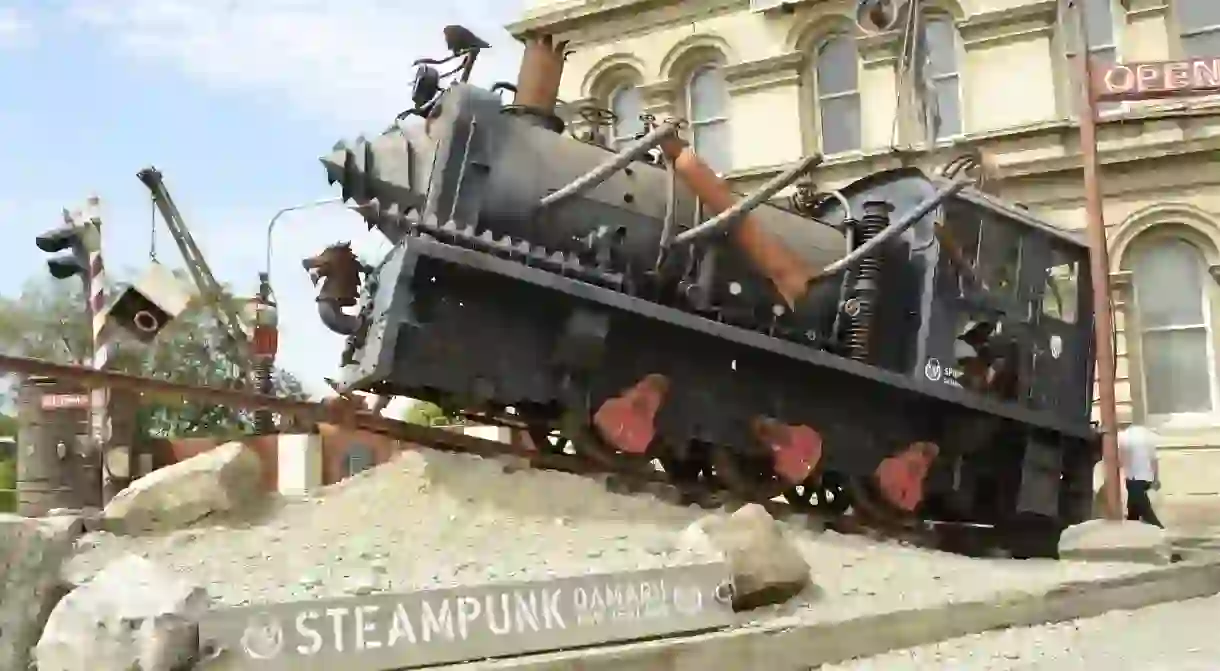10 Must-Visit Attractions in Otago, New Zealand

The South Island’s Otago region is filled with awesome attractions. Whether you want to immerse yourself in nature, would like to learn more about New Zealand history or want to admire some the country’s finest architecture, here are 10 incredible spots that everyone should visit.
Steampunk HQ
Museum

Over the years the Victorian town of Oamaru, just an hour and half’s drive away from Dunedin, has become New Zealand’s hub for all things steampunk. An annual steampunk festival put the town’s alternative culture into the world stage, but it is Steampunk HQ keeps this quirky identity alive throughout the year. True to its retro-futuristic affinities, this museum is quite interactive and features a collection of artwork, regular movie screenings, sculpture and sound exhibits.
Royal Albatross Centre
Natural Feature

Taiaroa Head, on the Otago Peninsula, is truly one of a kind. Nt only is it home to an array of unique New Zealand wildlife, it is also home to the Royal Albatross Centre – the world’s only mainland breeding colony for these remarkable bird species. The centre offers guided tours around the headland, showcasing its history as well as bringing visitors up close to the nesting Royal Albatrosses (the breeding area is off-limits for self-guided tours), Stewart Island shags, fur seals, sea lions and penguin species that call this stretch of New Zealand coastline home.
Taieri Gorge Railway
Train Station

The scenic journey across the Taieri Gorge Railway is the ideal choice for those wanting to slowly ease themselves into the Otago region’s diversified landscapes. The trip departs from Dunedin, traversing the Taieri Gorge and River, 10 different tunnels and a dozen viaducts as it makes its way over to the towns of Middlemarch and Pukerangi. There are several minor stops along the way, allowing travellers to take plenty of snaps before reembarking onto the vintage train carriages to admire the passing vistas and listen to the on-board commentary about the area’s history.
Kawarau Gorge Suspension Bridge
Bridge

If you know a thing or two about Queenstown’s extreme sporting endeavours, you’ll already be familiar with this one. The Kawarau Gorge Suspension Bridge is where the world’s first commercial bungee jumping operations were established. The iconic structure is also part of the Queenstown Trail (a popular walking and cycling route that connects Queenstown to Arrowtown and Gibbston) and its namesake river is one of the main local go-tos for thrilling activities like jet boating and white-water rafting.
Bannockburn Sluicings Historic Reserve
Natural Feature

Bannockburn Sluicing Historic Reserve is adjacent from the Central Otago town of Bannockburn, just across the Kawarau river from its neighbour Cromwell (wine connoisseurs will recognise these two townships for their viticulture). These spliced-up hillsides and stark landscapes are set to make visitors feel like they’ve been transported into a classic Western movie, as well as offering a dramatic perspective of the region’s distinctive gold mining past. A one-and-a-half hour loop track provides access to the remains of several river dams, water railings and man-made caverns that have made the reserve a significant landmark in its own right.
Totara Estate
Building
Totara Estate is a historic North Otago farmland widely considered to be the birthplace of New Zealand’s meat export industry. The farm was established in the 1850s, making it one of the oldest in the region. It provided the first shipment of frozen mutton from New Zealand to England in 1880. These days, Totara Estate is a registered heritage site where visitors can learn all about farming as they marvel at the well-preserved relics of its homestead and stables.
Hayes Engineering Works & Homestead
Building

A popular stopover for walkers and cyclists exploring the Otago Central Rail Trail, Hayes Engineering Works and Homestead is a landmark of New Zealanders’ innate resourcefulness and innovative spirit. It was once the home and workshop of prolific inventor Ernest Hayes, an Englishman who settled in the region with his wife Hannah in 1882 and is credited with creating a number of tools and machinery that were embraced both domestically and overseas. One of Hayes’ most famous inventions was a fencing wire strainer, which is still widely used in farms across the globe to this day.
Olveston Historic Home
Museum

Once the residence of prominent Dunedin businessman David Theomin, Olveston Historic Home offers its visitors a taste of colonial life in the early 20th century. The opulent, 35-bedroom house was designed by acclaimed English architect Sir Ernest George in 1903, and constructed by Robert Miekle over a course of two years from 1904-1906. Olveston became a historic museum in 1967 and many of its original features prevail, including the Theomin family’s extensive collection of artworks, bronze statues, and Southeast Asian artefacts and ceramics dating as far back as the 18th century.
Larnach Castle
Building

The historic Larnach Castle was the only building of its kind in New Zealand until quite recently. The castle has had quite a colourful past – at one point, it used as a lunatic asylum – but has since been restored as a tourist attraction, accommodation and events venue. Local banker and politician William Larnach famously designed this lavish manor for his first wife Eliza in 1871. The exterior took 200 builders to construct over a period of three years; a further expansion of the original design took another 12 years to complete.
Dunedin Railway Station
Building

Famously New Zealand’s most photographed landmark, the Dunedin Railway Station is as much a key historic site as it is a dynamic feature of local city operations. At its prime, the train station was the country’s busiest – Dunedin was New Zealand’s main commercial centre by the time the railway network was inaugurated in 1906. While the station is no longer in use, it currently thrives as the venue for the iconic Otago Farmers Market, which takes place every Saturday, rain or shine. During the week visitors can freely explore the station’s well-preserved structure and the picturesque gardens that surround it.













